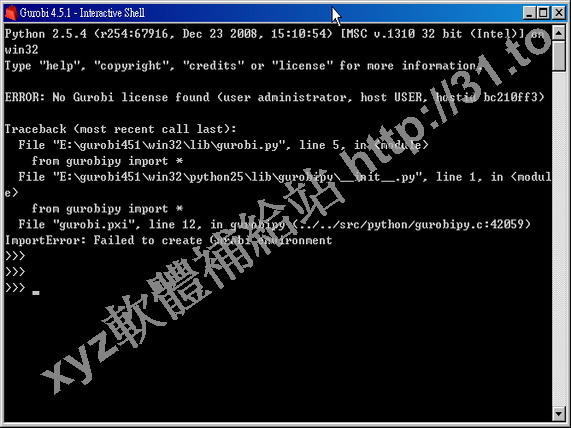Gurobi Optimization Gurobi v4.5.1 英文正式版(智慧引擎提供了新一代的高精確性的描繪軟體)
破解說明:
關掉主程式,破解檔放置於crack夾內,請將破解檔複製於主程式的安裝目錄內既可破解
內容說明:
Gurobi智慧引擎提供了新一代的高精確性的描繪方案。
英文說明:
The Gurobi Optimizer is a state-of-the-art solver
for linear programming (LP), quadratic programming
(QP) and mixed-integer programming (MILP and MIQP).
It was designed from the ground up to exploit modern
multi-core processors. Every Gurobi license allows
parallel processing, and the Gurobi Parallel
Optimizer is deterministic: two separate runs on the
same model will produce identical solution paths.
For solving LP and QP models, the Gurobi Optimizer
includes high-performance implementations of the
primal simplex method, the dual simplex method, and
a parallel barrier solver. For MILP and MIQP models,
the Gurobi Optimizer incorporates the latest methods
including cutting planes and powerful solution
heuristics. All models benefit from advanced
presolve methods to simplify models and slash solve
times.
The Gurobi Optimizer is written in C and is
accessible from several languages. In addition to a
powerful, interactive Python interface and a
matrix-oriented C interface, we provide
object-oriented interfaces from C++, Java, Python,
and the .NET languages. These interfaces have all
been designed to be lightweight and easy to use,
with the goal of greatly enhancing the accessibility
of our products. And since the interfaces are
lightweight, they are faster and use less memory
than other standard interfaces. Our online
documentation (Quick Start Guide, Example Tour and
Reference Manual) describes the use of these
interfaces.
Gurobi is also available through several powerful
third-party modeling systems including AIMMS, AMPL,
FRONTLINE SOLVERS, GAMS, MPL, OptimJ and TOMLAB.
Most of the changes in the 4.5 release of the Gurobi
Optimizer are related to performance. Users of
previous versions will typically not need to make
any changes to their programs to use the new
version. The new version does contain a few new
features, described here.
* New default Method for continuous models: The
new version uses a new Automatic setting as the
default for solving continuous models. In previous
releases, continuous models were solved with the
dual simplex method by default. While the exact
strategy used by the new Automatic setting may
change in future releases, in this release the new
approach uses the concurrent optimizer for
continuous models with a linear objective (LPs),
the barrier optimizer for continuous models with a
quadratic objective (QPs), and the dual simplex
optimizer for the root node of a MIP model. You
should change the Method parameter if you would
like to choose a different method.
* New Minimum Releaxation heuristic: The new
version contains a new Minimum Relaxation
heuristic that can be useful for finding solutions
to MIP models where other strategies fail to find
feasible solutions in a reasonable amount of time.
Use the new MinRelNodes parameter to control this
new heuristic.
* New branch direction control: The new version
allows more control over how the branch-and-cut
tree is explored. Specifically, when a node in the
MIP search is completed and two child nodes,
corresponding to the down branch and the up branch
are created, the new BranchDir parameter allows
you to determine whether the MIP solver will
explore the down branch first, the up branch
first, or whether it will choose the next node
based on a heuristic determination of which
sub-tree appears more promising.
* Cut pass limit: The new version allows you to
limit the number of cut passes performed during
root cut generation in MIP. Use the new CutPasses
parameter.
* Additional information for infeasible and
unbounded linear models: The new version allows
you to obtain a Farkas infeasibility proof for
infeasible models, and an unbounded ray for
unbounded models. Use the new InfUnbdInfo
parameter, and the new FarkasProof, FarkasDual,
UnbdRay attributes to obtain this information.
圖片說明:
![]() 相關商品:
Wiley RFID for the Optimization of Business Processes Apr 2008 英文正式版(PDF格式電子書)
相關商品:
Wiley RFID for the Optimization of Business Processes Apr 2008 英文正式版(PDF格式電子書)


